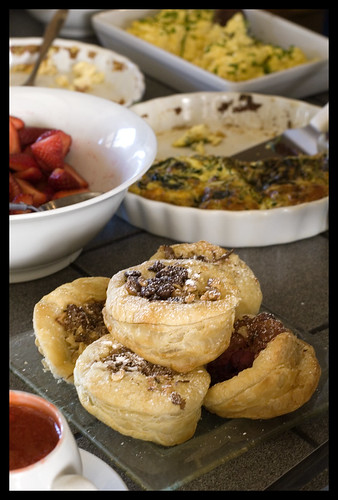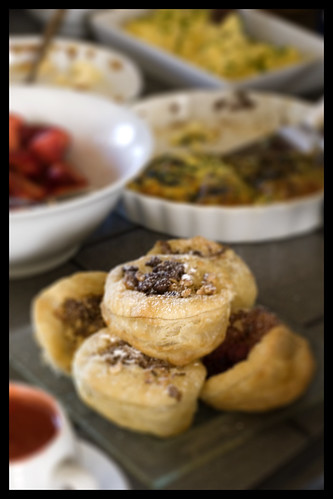Faking it: Tilt Shift effect in Photoshop
If you follow the general photography scene, it’s a bit hard to miss all of the recent photos that use a Photoshopped “tilt-shift” effect to make life size objects look miniature. Flickr has over 2800 photos tagged with tiltshift as well as 30 semi-related groups. The effect is actually very easy to achieve, once you find the right photo. The tutorial I learned from is here, on Receding Hairline.
What I haven’t seen much of is this effect applied to food photography, and I think there could be some interesting results.
For example, it’s a great way to correct a shot if you’ve given it too deep of a depth of field. The lens blur filter, along with a graduated mask, provides a close approximation of a narrow depth of field. It’s not perfect, but it’s good enough for a blog.
Here’s a shot that I took of breakfast at The Inn at Langley last weekend. I was trying to to get in the way of folks trying to get their food, so I just snapped a couple of quick ones of the buffet table. When I got home, and looked at the photos, I was disappointed that the shot was so harsh. I almost just trashed them all, but then I decided I might be able to fix this one. For this particular shot, I made a clear departure from accuracy, focusing on the emotion I wanted the shot to portray.
Here’s the before photo:

Notice, there’s not central focus to the photo, and your eye tends to bounce all over the place. It shows a lot of good food, but it doesn’t really make you go “oh my god, I want to eat that right now!” (and trust me, it was all amazingly delicious…)
I applied a tilt-shift effect, following the extremes listed in the tutorial above to get this result:

A lighter hand on the radius and the highlights would have given a more real looking picture, but I kind of liked the extreme. It makes the photo all about that one chocolate, puff pastry tart and makes it look magically delicious while at the same time showing that there is lots of other food that is probably equally wonderful.
Of course, you could use the same effect to make mini-food… just pick a photo with a wide angle, taken from above, and play with it… you may end up making some beautiful looking banquets for all the people living in the mini-world.
Technorati Tags: Food, Photography, Photoshop, Tips
Interesting tutorial.
my personal opinion here: I am getting tired of this kind of tilt-and-shift effect (or something similar) when it comes to food photography — David Loftus overused it in one of Jamie Oliver’s cookbooks (it was prob. just a very shallow DOF, but the effect is similar) — sure it has its uses, but not for almost every shot in a book, surely.
That said 🙂 I think in your example it most certainly helps the image, as the background is too busy in the original, and using this type of selective focus really does draw the eye to the delicious-looking tarts — so this is indeed good use of the effect.
But, I am sure the tarts would have looked better with a completely different background
First time reading your blog tonight- and I am amazed at the wealth of information I am finding here!
I really sense the need to dig through your archives and work out a tutorial session for myself.
you have a wonderful eye for pattern and relation in your foods.
Wow. thanks for linking that tutorial. I am an extremely novice food photographer and just have done my stuff for fun. I don’t even have photoshop but maybe I should get it. I linked your site so I can always find you!
My Life As A Reluctant Housewsife
Jack – thanks
AJ – Fair. The effect isn’t for everything… but it is kind of fun to do your own! I don’t know if the Jamie Oliver cookbooks use actual tilt shift lenses… certainly very shallow depth of field. I happen to be a fan of the style, although I agree it’s nice to have some variety. And, yeah… the tart looked better on it’s own.
McAuliflower & Gabriella – Thanks for stopping by! I’ve really just started this blog (in March), so expect even more in the future!
Ohh, thank you for sharing that tutorial! I just discovered this blog, and I’m happily browsing through your writings. I love photography and am on the verge of getting my first dslr, and fun tricks like this are great to learn 🙂
I can’t believe I’m just getting around to reading this entry. Shame on me… bad Matt bad Matt!
Ok, some background here on the tilt shift thing when it comes to food.
Years ago, before digital became as affordable and flexible as it is now, most food (if not all) was shot 4×5 film. Even to this day it’s still the best for capturing food – the color saturation, depth of field and information can’t be beat.
With that said, shooting film is a major pain in the ass! Polaroids, waiting for test shots, etc.
Where was I? Oh yes, tilt shift with food. Because of the mechanics of the large format camera and its billows, playing with planes of focus and depth of field was easy and made for visual interest. When we all made the switch to digital we didn’t have that same kind of play, and that’s where the tilt-shift came into the picture. With the t/s you can now get that same look and feel as you did with the 4×5 (well, almost).
I agree though – it’s SO completely overused now and it drives me batty. But it’s still beautiful when appropriate.
Your tutorial rocks!
Matt- it’s always so nice to hear from you!
Thanks for the great info here… As I’ve done more, I’ve decided I REALLY do need to start playing with a tilt-shift lens. I just wish they weren’t so expensive. The good news is that RentGlass.com has one for Canons. The bad news is that they only have a 24mm TS. Guess I’ll have to keep my eyes out for a good used one somewhere.
Hi .. im a budding photographer who’s interested in food photography and need somebody to show me the ropes… well, more like i need a third eye to help critique my work. Are you open to this?